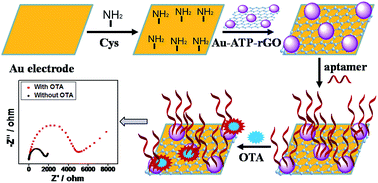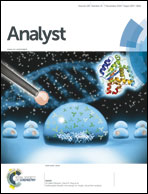Highly sensitive impedimetric aptasensor based on covalent binding of gold nanoparticles on reduced graphene oxide with good dispersity and high density
Abstract
A series of gold nanoparticles (AuNPs) that were covalently bound to 2-aminothiophenol-functionalized reduced graphene oxide (Au-ATP-rGO) composites have been synthesized with well-dispersed and controllable surface coverage of AuNPs. Aptamer immobilization capacity studies demonstrated that the surface density of AuNPs played a key role in increasing the amount of anchoring aptamers to enhance the sensitivity of affinity based detection. With the composites possessing dense surface coverage of AuNPs as a versatile signal amplified platform, a label-free aptasensor for the sensitive and selective detection of small molecules (ochratoxin A in this case) has been developed using electrochemical impedance spectroscopy (EIS). A wide linear range of 0.1–200 ng mL−1 was obtained with a low detection limit of 0.03 ng mL−1 (S/N = 3). This work provides a universal strategy for the sensitive detection of a variety of targets in a truly label-free manner by means of changing the corresponding aptamer. The promising platform based on the combination of Au-ATP-rGO composites, EIS technique, and aptamers would have great potential applications in clinical diagnosis, environmental analysis, and food safety monitoring.


 Please wait while we load your content...
Please wait while we load your content...